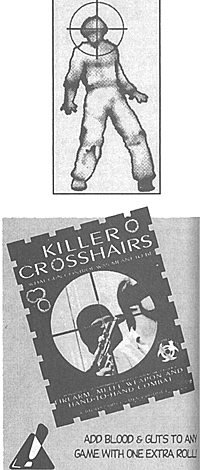
Biohazard Games
$10/24 pgs + 2 transparencies
If you're like me, you are never satisfied with any roleplaying game right out of the box. I all too often find myself "tsk"ing under my breath as I inspect weapons tables and combat rules. Always in search of the ever-elusive super- accurate method of conducting RPG combat, I found myself turning to more and more complex sets of rules. Oh sure, it was innocent enough at first - Traveler: 2300. Who could forget those great rules for tamping explosive charges?
But that was just the beginning. I knew I had a problem when I wrote five pages of rules for modeling radiation poisoning. All too soon I found myself spiraling downward into a Stygian abyss populated with the densest tables and charts Man has yet to devise: Phoenix Command. Don't get me wrong; it's still a great product, but it does not lend itself well to roleplaying.
I've managed to kick the extreme realism habit, mostly, over the last couple of years by playing a lot of White Wolf games and AD&D.
But I just und something that might push me right back over the edge. It's Killer Crosshairs from Biohazard Games. KC is a generic system for adding realism to ranged and hand-to-hand combat in any system. It works like this: you place a transparent template over a drawing of your target, centered on your point of aim. (The book is full of drawings of people and creatures in various poses.) Make your roll, and depending on how much you missed by, or how much you exceeded your target score by, you move the point of impact. This way, you know immediately where your shot went, and the GM can determine the consequences. (If you've played Millennium's End, you'll be familiar with this idea already.) There's one radial template for ranged attack deviation, and one curious- looking linear one for hand-to-hand weapons.
Hand-in-hand with the deviation system go the detailed damage charts. Once someone has been shot, stabbed, bludgeoned, or otherwise mangled, you can get the lowdown on just how bad a day they are actually having. It's far more entertaining than merely subtracting hit points, and a lot quicker than using the Phoenix Command Advanced Damage Tables, as much as I love them. (It's a personal crusade to find a way to elegantly incorporate projectile impact bite angle calculations into roleplay rules... but I digress!)
For example, say someone gets shot in the throat for, oh, 25% of their total hit points. This is what the entry reads:
- "Heavy bleeding and serious tissue
damage.
Trachea crushed 20%, speech impossible if crushed. Suffocation
trachea crushed; incapacitated
Bleed for 10% of hits/minute.
Mental actions - 10%." Yeah! Now we're gettin' somewhere!
The best part is that it only takes one additional die roll and one table lookup to get this extra level of detail. Sure, you might not want to do this if you are running a scenario where the players are engaging a horde of 50 orcs, but if it's smaller, cozier battle everyone will enjoy the extra detail. Since everything is given as percentages, it's easy to adapt the system to whatever RPG you happen to be playing. Give it a shot!
Back to Shadis #26 Table of Contents
Back to Shadis List of Issues
Back to MagWeb Master List of Magazines
© Copyright 1996 by Alderac Entertainment Group
This article appears in MagWeb (Magazine Web) on the Internet World Wide Web.
Other military history articles and gaming articles are available at http://www.magweb.com